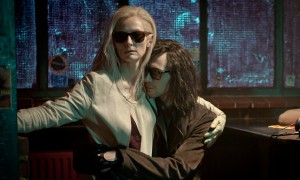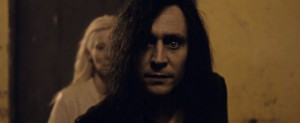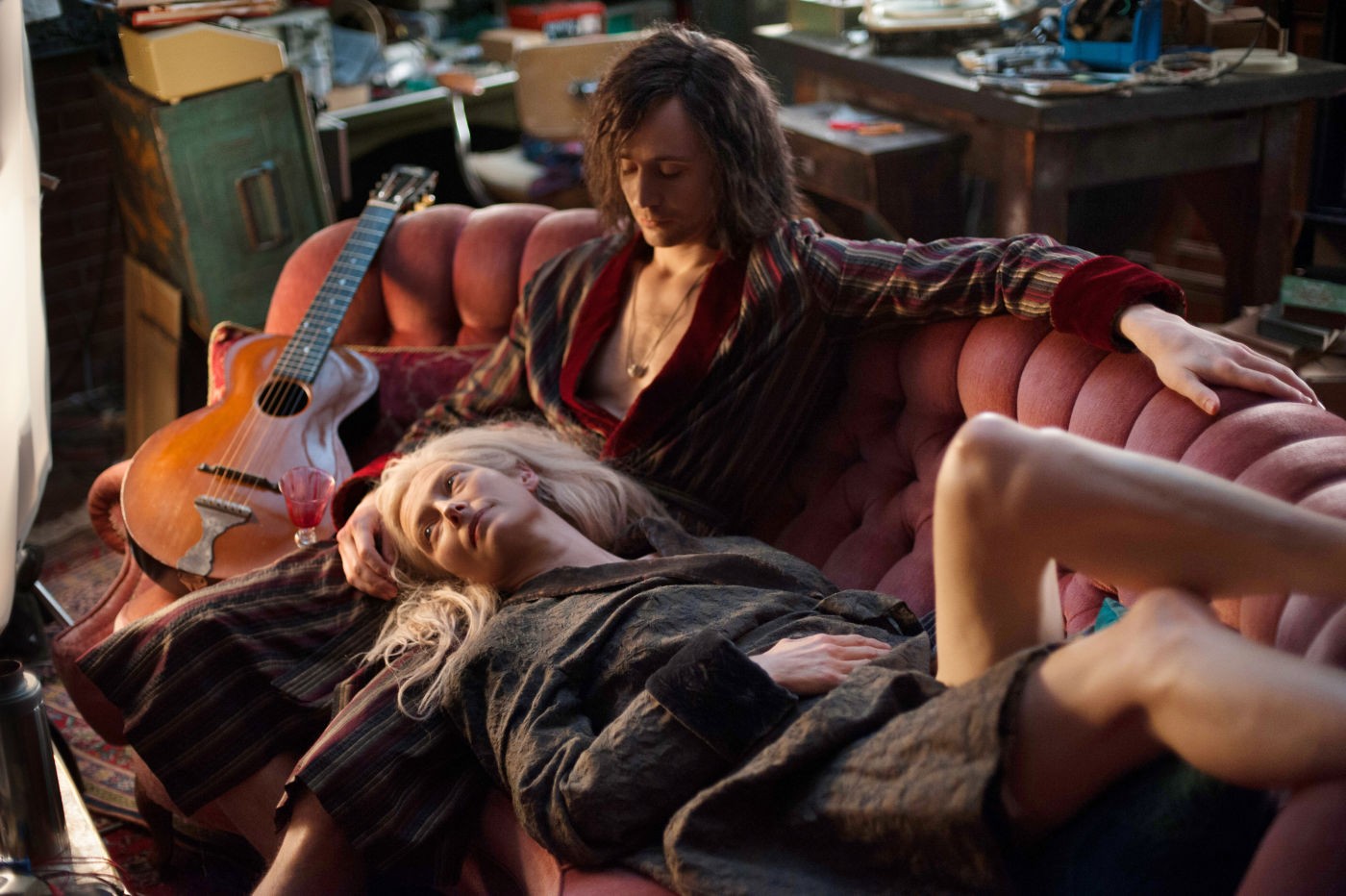Jim Jarmusch’s recent release, Only Lovers Left Alive, is not a successful film in the conventional sense; yet I wonder now whether I should cherish it all the more for that very reason. I think my chief complaint about it is that it’s not a successful script – which is not exactly the same thing. There’s not a lot of plot to begin with, which is not itself an overwhelming problem. The film works on a certain level as a mood piece – and to the extent that I still feel melancholy more than 24 hours later, I would say it’s effective. Parts of it are quite beautiful, and the footage of Detroit’s variously urban, industrial and suburban ruins is surpassing excellent. (One of these segments also offers a slender ray of hope; there are no others for the duration of the two-plus hour film.) Adam and Eve (of course) are estranged lovers, each absorbed in careers half a world away from each other – careers which might easily be pursued in either location, but which have followed their own eccentric trajectories (they’re artists: he’s a genius musician and composer; she’s a poet and litterateur), over years which stretch into … centuries. They’re vampires – of course.
Reclusive for obvious reasons, Adam (Tom Hiddleston) is nevertheless an underground sensation, whose music in various forms (mostly pirated, because of an unrelenting perfectionism which rarely allows him to release his music to the (well) light of day, as well as the difficulties, presumably both legal and practical, of doing business with him) is heard in the hippest places all over the world. He is also dark and moody, probably manic-depressive, though the extra centuries seem to have washed away the manic side entirely. Now, between solitary and less than satisfactory jags of instrumentalizing, recording and editing, he finds himself seriously depressed and contemplating the all-too-thinkable. A bit short on firepower (even a genius might be permitted to stick to his own field of passion and expertise), he enlists one of his (perhaps his only) trusted “zombies” (Anton Yelchin) – as he refers to most of the seven billion mortals currently overpopulating the planet – to procure a single custom-made bullet for an ancient revolver. His loneliness is answered by his paramour’s (Tilda Swinton) more transparent yearnings across the world in Tangier, where she not only has a safe and steady supply of the vampire’s eau de vie, but charming company to provide it – Christopher Marlowe (John Hurt), who seems to have survived plagues, mischief and murder plots by way of the vampire’s kiss. She agrees to join Adam, and, after packing a small traveling library (a charming detail) in a dozen languages, flies off to Detroit.
There, the Russian roulette business we think is going to be the central emotional drama is short-circuited by Eve’s discovery of the gun and the customized bullet. But new dramas (or opportunities for drama) crop up. Rust never sleeps, as Neil Young reminded us; and avid rock fans occasionally beat a path to his house in one of the new wildernesses on Detroit’s edge. Adam thinks his trusted procurer Ian may also be a leak (and he might be – but ultimately this plot line goes nowhere). The lovers share disturbing dreams involving Eve’s sister, Eva (Mia Wasikowska), eternal party girl, now based in a city Adam views as zombie capital of the world – Los Angeles. (Is he very far off?) And voilà – there she is, looking as if she just flew in from an evening’s clubbing. (Her look is classic – baby-doll mini-dress, furry/feathery coat, silver mary-janes – L.A. club girl with a retro-Edie Sedgwick vibe.) It seems that’s one way vampires communicate – the dream internet. The couple reluctantly take Eva out to a rock club one evening to take in the local scene and connect with their favorite zombie. The evening’s debauch effectively bleeds off a few more plot opportunities, and the film flows haltingly to its end. 
Unlike one of its cinematic predecessors, say, Tony Scott’s The Hunger, there is very little actual or psychological momentum that builds towards a central conflict, much less any secondary conflicts or plot lines. Nor is there any resolution along the lines of that or other vampire films, whether of the post-adolescent or merely post-Dracula variety (in other words, films which more or less take the vampire phenomenon as an established actuality), or serial television dramas (e.g., True Blood). Such resolutions are usually weak and Jarmusch was probably smart to dispense with that extraneous notion.
Still what we’re left with is an exhaustion that almost eclipses ‘hunger.’ These are two people whose (multiple) lives are all about the pursuit of art and the perfection of their arts; lovers, for whom love can never be enough. Eva is reckless, wanton and murderously destructive in her pursuit of pleasure. Her kind of sharing is entirely capricious. She will always take more than her share. Love is a pretty idea, but her hunger eclipses love (even, conceivably, self-preservation). But she’s free. Adam and Eve are slaves to their art. (Even in the grip of his blood-hunger, he finds himself mesmerized by a singer in a café – while Eve is tracking down yet another instrument for him.) They’re almost as attracted to their final victims as they are hungry for them. It’s as if beauty were a fate worse than death. (Is this Jarmusch’s cinematic envoi – his dernière bouchée? A last bénédiction de sang?)
 No – they really don’t make movies the way they used to. But then what would that kind of movie look like or mean in the context of a planetary reality that makes Inoshiro Honda look like Walt Disney?
No – they really don’t make movies the way they used to. But then what would that kind of movie look like or mean in the context of a planetary reality that makes Inoshiro Honda look like Walt Disney?
I’m not sure if that explains why so-called ‘action’ movies are so unsatisfactory in recent years. The special effects are always trumpeted in the publicity, but on screen they really don’t add up to much: one more spectacular explosion or collision or shattering of machine parts and splatter of flesh and bone. It always feels like a roller-coaster heading relentlessly down.
The fine arts are not immune from this phenomenon. There’s an entire genre of abstract painting and sculpture that resembles some metastatic cancer of Jasper Johns’ oft-quoted basic strategy – “Take an object; do something to it; do something else to it.” (I won’t cite specific examples; and frankly the names of the more egregious exemplars tend to blur with the works themselves. It’s pretty random, but essentially this is the kind of stuff you try to get away from as quickly as possible and into the back room or to the closest bar for a large scotch or martini.)
At the other – exhausted, rather than simply obliterated – end of this spectrum, you see a lot of painting, sculpture and mixed media work that seems deliberately unresolved, hovering, blurring or bleeding at the edges – if edge is even defined. (‘Provisional’ is another word that’s sometimes applied. Wouldn’t you know I’d find an invite to an upcoming group show in this vein in my e-mail inbox the evening before this goes up, titled, Not-Knowing?) There are exceptions; and this aspect of sculpture or three-dimensional work is usually held in check by the physical space the work occupies. Artists who work in full-scale installations tend either to deliberately exploit the blur between the work and a quotidian actuality; or steer clear of it entirely, emphasizing an abstract unity.
One (the carcinogenic) is a kind of art (or art-making) by accumulation; the other is an art by appropriation – not simply re-contextualized or de-contextualized, but re-composed, edited, turned into something else, and something else again, both partially layered and partially scraped away (or simply blurred). Then, too, there’s the kind of fragmentation that becomes an aperture on something larger. I had a very recent experience of this where the artist – using appropriated materials, imagery – unspooled a kind of doodle or calligraphy that elaborated both on certain aspects of the imagery, their affect or attempted affect, and the artist’s own affective response and consideration. It both broke up/down the image (and even the sense of time), and extended it into something else entirely.
I’m not trying to make a simplistic comparison about the exhaustion of one medium or another; or what’s rapidly become a common trope of contemporary narrative film-making and strategies in contemporary fine arts, generally. But we seem to be hovering over a more direct acknowledgment of both material and intellectual limits. The material limits are real – a measure of the physical realities of environmental (and consequent cultural) collapse in evidence all around us. The intellectual limits are largely self-imposed – products of the conventions and shopworn constructs of a dessicated Conceptualism and post-conceptualism that has really stayed too long at the art fair.
It’s a kind of precious cannibalism – and I don’t mean that entirely in a pejorative sense. We’re coming to grips with a hunger far more consuming than any recognizable intellectual motives, conceptual or symbolic equivalents – something that almost demands a new or transformed symbolic language. It’s becoming impossible to be satisfied with anything less than ideas that are overwhelmed by that hunger, that materiality. Anything less seems false, or strained or fake. Hence our fascination with the hand-crafted, the heightened tactile, as well as visual/aural/olfactory senses.
In the Jarmusch(Sony/Soda/Pandora) film, Eve (Swinton) takes the long view. With a few centuries on her lover, she might. Plagues, inquisitions, big fires, big freezes – the poets and composers go on – and some of them happen to be vampires, too. But something has changed and Eve gets that. It’s not just a dark age, but a faithless (not to mention feckless) one. Most of us ‘zombies’ are just that – flesh-eaters eating our own flesh; couch-surfing between disasters, not so different from Eve’s sister. We’re living on borrowed blood (oil, water, fill-in-the-blanks….); but we’re going down and we’ll be taking whatever (and whoever) we need with us.


